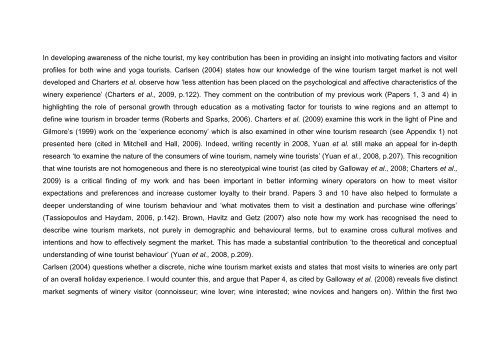The Role of Niche Tourism Products in Destination - Repository ...
The Role of Niche Tourism Products in Destination - Repository ...
The Role of Niche Tourism Products in Destination - Repository ...
Create successful ePaper yourself
Turn your PDF publications into a flip-book with our unique Google optimized e-Paper software.
In develop<strong>in</strong>g awareness <strong>of</strong> the niche tourist, my key contribution has been <strong>in</strong> provid<strong>in</strong>g an <strong>in</strong>sight <strong>in</strong>to motivat<strong>in</strong>g factors and visitor<br />
pr<strong>of</strong>iles for both w<strong>in</strong>e and yoga tourists. Carlsen (2004) states how our knowledge <strong>of</strong> the w<strong>in</strong>e tourism target market is not well<br />
developed and Charters et al. observe how ‘less attention has been placed on the psychological and affective characteristics <strong>of</strong> the<br />
w<strong>in</strong>ery experience’ (Charters et al., 2009, p.122). <strong>The</strong>y comment on the contribution <strong>of</strong> my previous work (Papers 1, 3 and 4) <strong>in</strong><br />
highlight<strong>in</strong>g the role <strong>of</strong> personal growth through education as a motivat<strong>in</strong>g factor for tourists to w<strong>in</strong>e regions and an attempt to<br />
def<strong>in</strong>e w<strong>in</strong>e tourism <strong>in</strong> broader terms (Roberts and Sparks, 2006). Charters et al. (2009) exam<strong>in</strong>e this work <strong>in</strong> the light <strong>of</strong> P<strong>in</strong>e and<br />
Gilmore’s (1999) work on the ‘experience economy’ which is also exam<strong>in</strong>ed <strong>in</strong> other w<strong>in</strong>e tourism research (see Appendix 1) not<br />
presented here (cited <strong>in</strong> Mitchell and Hall, 2006). Indeed, writ<strong>in</strong>g recently <strong>in</strong> 2008, Yuan et al. still make an appeal for <strong>in</strong>-depth<br />
research ‘to exam<strong>in</strong>e the nature <strong>of</strong> the consumers <strong>of</strong> w<strong>in</strong>e tourism, namely w<strong>in</strong>e tourists’ (Yuan et al., 2008, p.207). This recognition<br />
that w<strong>in</strong>e tourists are not homogeneous and there is no stereotypical w<strong>in</strong>e tourist (as cited by Galloway et al., 2008; Charters et al.,<br />
2009) is a critical f<strong>in</strong>d<strong>in</strong>g <strong>of</strong> my work and has been important <strong>in</strong> better <strong>in</strong>form<strong>in</strong>g w<strong>in</strong>ery operators on how to meet visitor<br />
expectations and preferences and <strong>in</strong>crease customer loyalty to their brand. Papers 3 and 10 have also helped to formulate a<br />
deeper understand<strong>in</strong>g <strong>of</strong> w<strong>in</strong>e tourism behaviour and ‘what motivates them to visit a dest<strong>in</strong>ation and purchase w<strong>in</strong>e <strong>of</strong>fer<strong>in</strong>gs’<br />
(Tassiopoulos and Haydam, 2006, p.142). Brown, Havitz and Getz (2007) also note how my work has recognised the need to<br />
describe w<strong>in</strong>e tourism markets, not purely <strong>in</strong> demographic and behavioural terms, but to exam<strong>in</strong>e cross cultural motives and<br />
<strong>in</strong>tentions and how to effectively segment the market. This has made a substantial contribution ‘to the theoretical and conceptual<br />
understand<strong>in</strong>g <strong>of</strong> w<strong>in</strong>e tourist behaviour’ (Yuan et al., 2008, p.209).<br />
Carlsen (2004) questions whether a discrete, niche w<strong>in</strong>e tourism market exists and states that most visits to w<strong>in</strong>eries are only part<br />
<strong>of</strong> an overall holiday experience. I would counter this, and argue that Paper 4, as cited by Galloway et al. (2008) reveals five dist<strong>in</strong>ct<br />
market segments <strong>of</strong> w<strong>in</strong>ery visitor (connoisseur; w<strong>in</strong>e lover; w<strong>in</strong>e <strong>in</strong>terested; w<strong>in</strong>e novices and hangers on). With<strong>in</strong> the first two
















